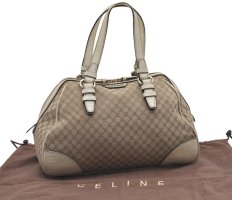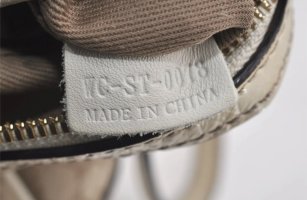Ok so I found this very interesting. It seems that back in 2005 Celine did produce a line of cheaper bags aimed at the younger crowd in Asia. These were mainly the macadam (canvas) bags. That explains why most of them being sold online now show up in Japan.
This was posted on TPF years ago. It’s a Wall Street Journal article:
Foreign Luxuries
Breaking a Taboo, High Fashion
Starts Making Goods Overseas
Euro's Rise, Low-Cost Rivals,
Labor Costs Spur Gamble;
Not Always 'Made in Italy'
Egyptians Suit Valentino
By ALESSANDRA GALLONI in Cairo, Egypt, CECILIE ROHWEDDER in London and TERI AGINSin New York
Staff Reporters of THE WALL STREET JOURNAL
September 27, 2005
A desert wind blows through the open windows of a factory in Cairo that harbors one of the biggest secrets in Italian high fashion: Egyptian tailors.
Women in head-scarves stitch shoulder seams, press wrinkles out of silk-lined pockets and weave Italian fabric through digital sewing machines. They're making $1,300 men's suits for Valentino, one of the most storied names in Italian luxury. They learned the craft from videotapes on TV sets positioned around the factory floor.
For years, European luxury-goods firms manufactured T-shirts and jeans in Eastern Europe and North Africa, but drew the line at their fanciest collections, which commanded premium prices precisely because they were "Made in Italy." Now, pushed by rising labor costs, currency fluctuations and competition from low-price brands, Valentino and other firms in Italy and France are breaking one of the strictest taboos in high fashion: they're starting to produce some of their most exclusive lines in developing countries.
Celine, a unit of luxury goods giant
LVMH Moët Hennessy Louis Vuitton SA, is manufacturing some handbags in China, including its denim-and-leather Macadam bags, which sell for $500, according to people familiar with the matter. Though it still makes its swankiest label in Italy, Giorgio Armani SpA says it produces 18% of its Armani Collezioni -- which pitches wool trousers for $450 and silk jackets for $1,500 -- in Eastern Europe.
Even "Made in Italy" stalwarts such as
Prada,
Gucci and Tod's say they are tiptoeing into foreign sourcing. Last year,
Gucci Group NV began sewing some sneakers at a factory in Serbia while leather-goods company
Tod's SpA produces a part of its Hogan sneaker line in Hungary and is considering moving that to China.
"What do you care where I make my shoes?" says Prada Group NV Chief Executive Patrizio Bertelli. Where local laws permit, Mr. Bertelli says he'd prefer to insert a "Made by Prada" tag in his products. In addition to sewing the upper part of some shoes in Slovenia, Prada makes pieces for some of its handbags in Turkey.
The move out of France and Italy is only just beginning. Fashion executives say some production won't ever move to low-cost countries because Italian craftsmanship is still unparalleled. Sophisticated items made in low volumes -- such as hand-woven leather handbags -- may always be "Made in Italy," for example. For the rest, the industry thinks it's only a matter of time.
"It will take another 15 years until luxury brands' main lines are completely delocalized, but it will happen," said Tonino Perna, chief executive of IT Holding SpA, which manufactures relatively affordable collections for labels such as Versace and Dolce & Gabbana. IT Holding makes about 30% of its clothes and accessories abroad. Executives say privately that more fashion brands are producing outside of Europe than the number who care to admit it.
This shift underscores how the developing world's manufacturing talent is improving to the point where even quintessential luxury products are starting to move offshore. It's also a sign of the extent to which high-end products are under pressure from low-cost alternatives.
Companies from sneaker makers to automotive giants have long outsourced to China and Mexico, but luxury-goods brands have always touted Italian and French production as essential to the luxury experience. The "Made in Italy" label, with its centuries-old history of artisanship, has justified exorbitant prices. If their clothes are stitched at low-cost factories, how will consumers react? Will luxury brands eventually have to bow to pressure and lower prices at the expense of their margins?
Many Italian fashion houses fear a backlash if they're seen hastening the decline of Italy's textile industry. For more than a century, that sector helped power the Italian economy, the fourth-largest in Europe. As companies outsourced production, sales of Italian textiles have fallen more than 10% in the past three years, with 24,000 textile manufacturing jobs lost last year, according to Italy's textile association. How to stop the trend, which is contributing to Italy's current economic malaise, is a hotly debated political issue.
"Our 'Made in Italy' has to be defended with force," Claudio Scajola, Italian Minister for Productive Activities, said at the Milan fashion shows, which started this week.
Alaa Arafa, the businessman who owns the Egyptian factory making Valentino suits, has little sympathy for such complaints. "Yes, some Italian jobs will be lost, but the writing is already on the wall," he says. "No Italian girl will sit at the sewing machine anymore, no matter how much you pay her."
As a result, executives are beginning to change their tune. "We can't be closed-minded. China will be part of the process for everybody," says Franco Pene, chairman of
Gibo SpA, a high-end Italian manufacturer that produces clothes for fashion labels Marc Jacobs, Michael Kors and Paul Smith. Gibo says that for now, it produces only in Italy.


